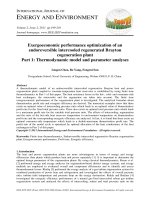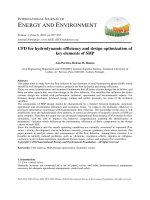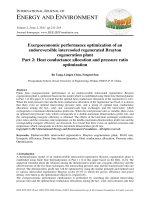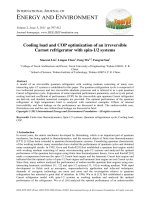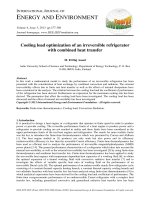Mathematical optimization
Bạn đang xem bản rút gọn của tài liệu. Xem và tải ngay bản đầy đủ của tài liệu tại đây (1.64 MB, 298 trang )
Convex Optimization — Boyd & Vandenberghe
1. Introduction
• mathematical optimization
• least-squares and linear programming
• convex optimization
• example
• course goals and topics
• nonlinear optimization
• brief history of convex optimization
1–1
Mathematical optimization
(mathematical) optimization problem
minimize f
0
(x)
subject to f
i
(x) ≤ b
i
, i = 1, . . . , m
• x = (x
1
, . . . , x
n
): optimization variables
• f
0
: R
n
→ R: objective function
• f
i
: R
n
→ R, i = 1, . . . , m: constraint functions
optimal solution x
has smallest value of f
0
among all vectors that
satisfy the constraints
Introduction 1–2
Examples
portfolio optimization
• variables: amounts invested in different assets
• constraints: budget, max./min. investment per asset, minimum return
• objective: overall risk or return variance
device sizing in electronic circuits
• variables: device widths and lengths
• constraints: manufacturing limits, timing requirements, maximum area
• objective: power consumption
data fitting
• variables: model parameters
• constraints: prior information, parameter limits
• objective: measure of misfit or prediction error
Introduction 1–3
Solving optimization problems
general optimization problem
• very difficult to solve
• methods involve some compromise, e.g., very long computation time, or
not always finding the solution
exceptions: certain problem classes can be solved efficiently and reliably
• least-squares problems
• linear programming problems
• convex optimization problems
Introduction 1–4
Least-squares
minimize Ax − b
2
2
solving least-squares problems
• analytical solution: x
= (A
T
A)
−1
A
T
b
• reliable and efficient algorithms and software
• computation time proportional to n
2
k (A ∈ R
k×n
); less if structured
• a mature technology
using least-squares
• least-squares problems are easy to recognize
• a few standard techniques increase flexibility (e.g., including weights,
adding regularization terms)
Introduction 1–5
Linear programming
minimize c
T
x
subject to a
T
i
x ≤ b
i
, i = 1, . . . , m
solving linear programs
• no analytical formula for solution
• reliable and efficient algorithms and software
• computation time proportional to n
2
m if m ≥ n; less with structure
• a mature technology
using linear programming
• not as easy to recognize as least-squares problems
• a few standard tricks used to convert problems into linear programs
(e.g., problems involving
1
- or
∞
-norms, piecewise-linear functions)
Introduction 1–6
Convex optimization problem
minimize f
0
(x)
subject to f
i
(x) ≤ b
i
, i = 1, . . . , m
• objective and constraint functions are convex:
f
i
(αx + βy) ≤ αf
i
(x) + βf
i
(y)
if α + β = 1, α ≥ 0, β ≥ 0
• includes least-squares problems and linear programs as special cases
Introduction 1–7
solving convex optimization problems
• no analytical solution
• reliable and efficient algorithms
• computation time (roughly) proportional to max{n
3
, n
2
m, F}, where F
is cost of evaluating f
i
’s and their first and second derivatives
• almost a technology
using convex optimization
• often difficult to recognize
• many tricks for transforming problems into convex form
• surprisingly many problems can be solved via convex optimization
Introduction 1–8
Example
m lamps illuminating n (small, flat) patches
PSfrag replacements
lamp power
p
j
illumination
I
k
r
kj
θ
kj
intensity I
k
at patch k depends linearly on lamp powers p
j
:
I
k
=
m
j=1
a
kj
p
j
, a
kj
= r
−2
kj
max{cos θ
kj
, 0}
problem: achieve desired illumination I
des
with bounded lamp powers
minimize max
k=1,...,n
| log I
k
− log I
des
|
subject to 0 ≤ p
j
≤ p
max
, j = 1, . . . , m
Introduction 1–9
how to solve?
1. use uniform power: p
j
= p, vary p
2. use least-squares:
minimize
n
k=1
(I
k
− I
des
)
2
round p
j
if p
j
> p
max
or p
j
< 0
3. use weighted least-squares:
minimize
n
k=1
(I
k
− I
des
)
2
+
m
j=1
w
j
(p
j
− p
max
/2)
2
iteratively adjust weights w
j
until 0 ≤ p
j
≤ p
max
4. use linear programming:
minimize max
k=1,...,n
|I
k
− I
des
|
subject to 0 ≤ p
j
≤ p
max
, j = 1, . . . , m
which can be solved via linear programming
of course these are approximate (suboptimal) ‘solutions’
Introduction 1–10
5. use convex optimization: problem is equivalent to
minimize f
0
(p) = max
k=1,...,n
h(I
k
/I
des
)
subject to 0 ≤ p
j
≤ p
max
, j = 1, . . . , m
with h(u) = max{u, 1/u}
0 1 2 3 4
0
1
2
3
4
5
PSfrag replacements
u
h(u)
f
0
is convex because maximum of convex functions is convex
exact solution obtained with effort ≈ modest factor × least-squares effort
Introduction 1–11
additional constraints: does adding 1 or 2 below complicate the problem?
1. no more than half of total power is in any 10 lamps
2. no more than half of the lamps are on (p
j
> 0)
• answer: with (1), still easy to solve; with (2), extremely difficult
• moral: (untrained) intuition doesn’t always work; without the proper
background very easy problems can appear quite similar to very difficult
problems
Introduction 1–12
Course goals and topics
goals
1. recognize/formulate problems (such as the illumination problem) as
convex optimization problems
2. develop code for problems of moderate size (1000 lamps, 5000 patches)
3. characterize optimal solution (optimal power distribution), give limits of
performance, etc.
topics
1. convex sets, functions, optimization problems
2. examples and applications
3. algorithms
Introduction 1–13
Nonlinear optimization
traditional techniques for general nonconvex problems involve compromises
local optimization methods (nonlinear programming)
• find a point that minimizes f
0
among feasible points near it
• fast, can handle large problems
• require initial guess
• provide no information about distance to (global) optimum
global optimization methods
• find the (global) solution
• worst-case complexity grows exponentially with problem size
these algorithms are often based on solving convex subproblems
Introduction 1–14
Brief history of convex optimization
theory (convex analysis): ca1900–1970
algorithms
• 1947: simplex algorithm for linear programming (Dantzig)
• 1960s: early interior-point methods (Fiacco & McCormick, Dikin, . . . )
• 1970s: ellipsoid method and other subgradient methods
• 1980s: polynomial-time interior-point methods for linear programming
(Karmarkar 1984)
• late 1980s–now: polynomial-time interior-point methods for nonlinear
convex optimization (Nesterov & Nemirovski 1994)
applications
• before 1990: mostly in operations research; few in engineering
• since 1990: many new applications in engineering (control, signal
processing, communications, circuit design, . . . ); new problem classes
(semidefinite and second-order cone programming, robust optimization)
Introduction 1–15
Convex Optimization — Boyd & Vandenberghe
2. Convex sets
• affine and convex sets
• some important examples
• operations that preserve convexity
• generalized inequalities
• separating and supporting hyperplanes
• dual cones and generalized inequalities
2–1
Affine set
line through x
1
, x
2
: all points
x = θx
1
+ (1 − θ)x
2
(θ ∈ R)
PSfrag replacements
x
1
x
2
θ = 1.2
θ = 1
θ = 0.6
θ = 0
θ = −0.2
affine set: contains the line through any two distinct points in the set
example: solution set of linear equations {x | Ax = b}
(conversely, every affine set can be expressed as solution set of system of
linear equations)
Convex sets 2–2
Convex set
line segment between x
1
and x
2
: all points
x = θx
1
+ (1 − θ)x
2
with 0 ≤ θ ≤ 1
convex set: contains line segment between any two points in the set
x
1
, x
2
∈ C, 0 ≤ θ ≤ 1 =⇒ θx
1
+ (1 − θ)x
2
∈ C
examples (one convex, two nonconvex sets)
Convex sets 2–3
Convex combination and convex hull
convex combination of x
1
,. . . , x
k
: any point x of the form
x = θ
1
x
1
+ θ
2
x
2
+ ··· + θ
k
x
k
with θ
1
+ ··· + θ
k
= 1, θ
i
≥ 0
convex hull conv S: set of all convex combinations of points in S
Convex sets 2–4
Convex cone
conic (nonnegative) combination of x
1
and x
2
: any point of the form
x = θ
1
x
1
+ θ
2
x
2
with θ
1
≥ 0, θ
2
≥ 0
PSfrag replacements
0
x
1
x
2
convex cone: set that contains all conic combinations of points in the set
Convex sets 2–5
Hyperplanes and halfspaces
hyperplane: set of the form {x | a
T
x = b} (a = 0)
PSfrag replacements
a
x
a
T
x = b
x
0
halfspace: set of the form {x | a
T
x ≤ b} (a = 0)
PSfrag replacements
a
a
T
x ≥ b
a
T
x ≤ b
x
0
• a is the normal vector
• hyperplanes are affine and convex; halfspaces are convex
Convex sets 2–6
Euclidean balls and ellipsoids
(Euclidean) ball with center x
c
and radius r:
B(x
c
, r) = {x | x − x
c
2
≤ r} = {x
c
+ ru | u
2
≤ 1}
ellipsoid: set of the form
{x | (x − x
c
)
T
P
−1
(x − x
c
) ≤ 1}
with P ∈ S
n
++
(i.e., P symmetric positive definite)
PSfrag replacements
x
c
other representation: {x
c
+ Au | u
2
≤ 1} with A square and nonsingular
Convex sets 2–7
Norm balls and norm cones
norm: a function · that satisfies
• x ≥ 0; x = 0 if and only if x = 0
• tx = |t|x for t ∈ R
• x + y ≤ x + y
notation: · is general (unspecified) norm; ·
symb
is particular norm
norm ball with center x
c
and radius r: {x | x − x
c
≤ r}
norm cone: {(x, t) | x ≤ t}
Euclidean norm cone is called second-
order cone
PSfrag replacements
x
1
x
2
t
−1
0
1
−1
0
1
0
0.5
1
norm balls and cones are convex
Convex sets 2–8
Polyhedra
solution set of finitely many linear inequalities and equalities
Ax b, Cx = d
(A ∈ R
m×n
, C ∈ R
p×n
, is componentwise inequality)
PSfrag replacements
a
1
a
2
a
3
a
4
a
5
P
polyhedron is intersection of finite number of halfspaces and hyperplanes
Convex sets 2–9
Positive semidefinite cone
notation:
• S
n
is set of symmetric n × n matrices
• S
n
+
= {X ∈ S
n
| X 0}: positive semidefinite n × n matrices
X ∈ S
n
+
⇐⇒ z
T
Xz ≥ 0 for all z
S
n
+
is a convex cone
• S
n
++
= {X ∈ S
n
| X 0}: positive definite n × n matrices
example:
x y
y z
∈ S
2
+
PSfrag replacements
x
y
z
0
0.5
1
−1
0
1
0
0.5
1
Convex sets 2–10


